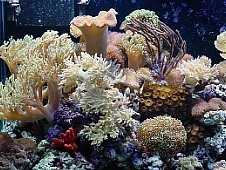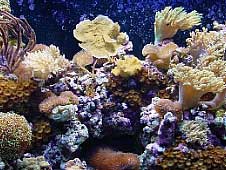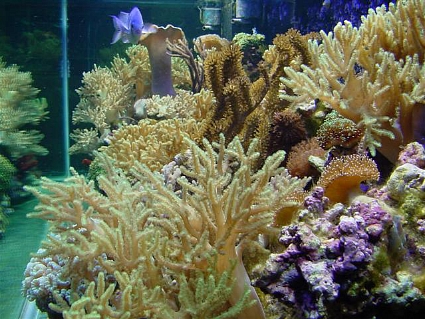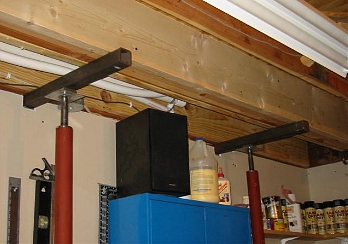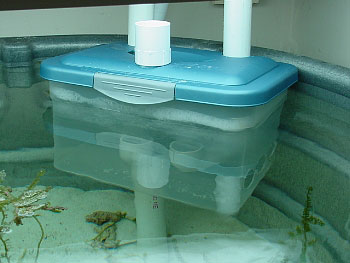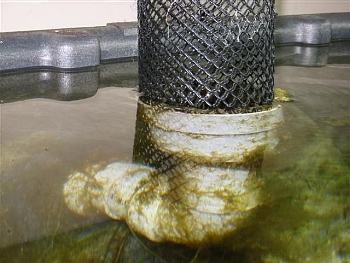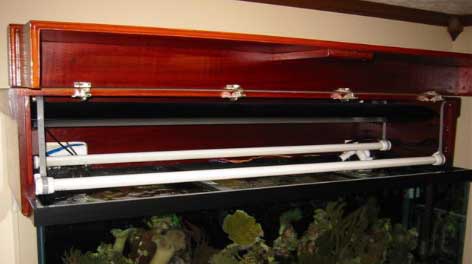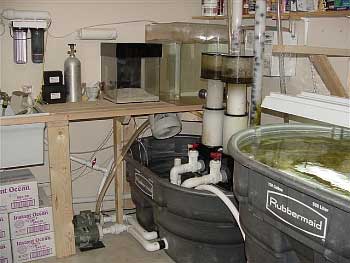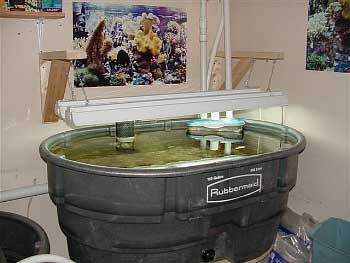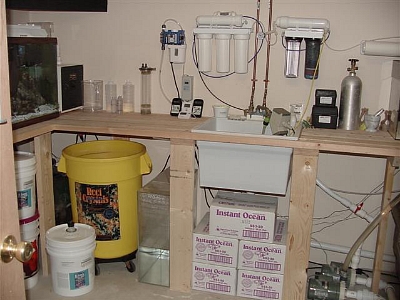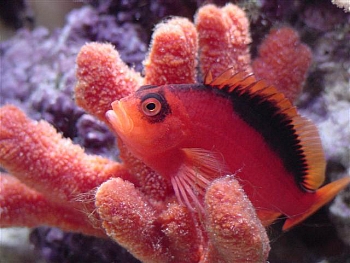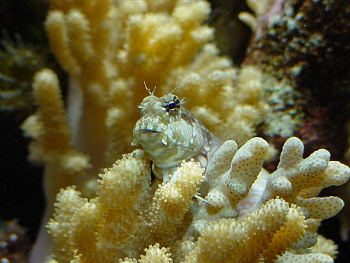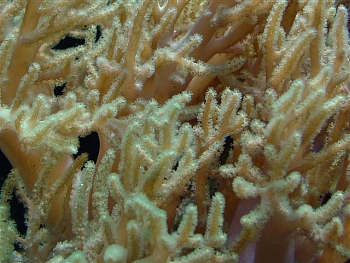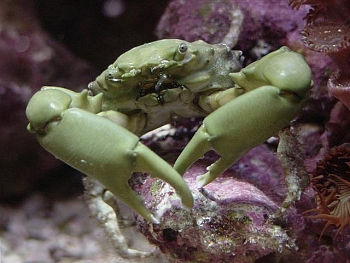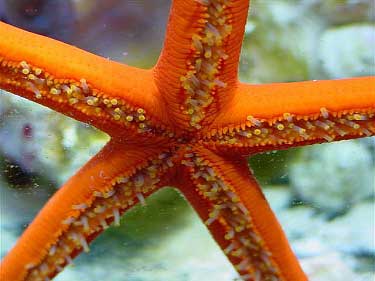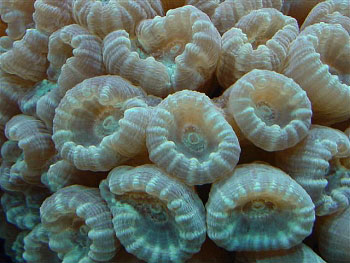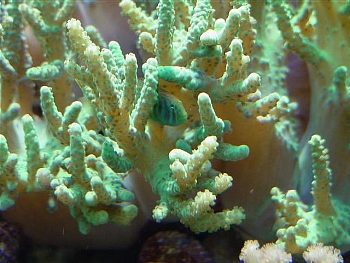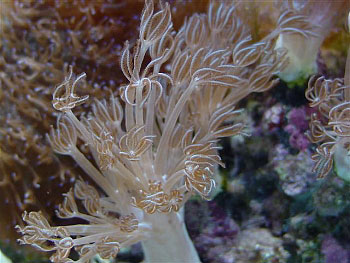
|
|
|
Ryan Baker's (rbaker) Reef Tank Background: I set up my first aquarium in 1988; it was a 55 gal freshwater tank, and was the beginning of a long love affair with aquariums. By the end of 1989, I had a 150 gallon fish-only saltwater tank in my living room, a 90 gallon saltwater tank in my bedroom, and a 40 gallon anemone tank in the basement. A few years later, I started my first full-fledged reef tank.
Aquarium Profile: Prior to setting up the tank, I spent
several months designing the system. It's a standard 180
gallon All-Glass model tank measuring 74" x 24"
x 24". I'm using the Berlin method (bare bottom) with
350 lbs. of Fiji and Marshall Island live rock. However,
since I still wanted to take advantage of the benefits of
a deep sand bed, I installed a 150 gallon refugium containing
450 lbs. of live sand, which brings the sand bed depth to
around 5". I also have a 150 gallon sump making the
total system volume approximately 400 gallons. This tank
replaced a 75
gallon reef that was up for about 5 years. I made the stand and canopy out of Jatoba
(Brazilian Cherry wood). The stand is 38" tall and the
canopy is 15" tall, giving a total height of the system
to 76". I used a natural Danish oil finish and three
coats of marine grade spar varnish both inside and out to
protect the wood. Due to the weight of the tank (approx. 2500
lbs.), and the fact that the tank runs parallel to the floor
joists, I had to reinforce the floor with extra joists and
support posts directly under the tank in the basement. Check
out the slideshow below containing some of the construction
progress:
Plumbing and Circulation: The reef is in the dining room on the second floor and all of the equipment is located in my basement fish room. A large overflow box is used with two 1 ¼" drains that go through the floor, then 40 feet across the house and into the fish room. It enters the 150 gallon refugium via a do-it-yourself baffle box to keep salt spray to a minimum (see below). The refugium overflows into a 150 gallon sump where the water is skimmed, and then sent back up to the main tank via an Iwaki MD70RLT pump. Approximately 1100gph is running through the system. For additional circulation within the main tank, a closed-loop re-circulating system is powered by a Little Giant 4-MDQX-SC that pushes 1325gph. Additional circulation is provided by a Supreme Mag 7 buried behind the reef (700gph) and four Maxi-Jet 1200 powerheads, which are controlled by a Tsunami wavemaker. This results in a total turnover of approximately 4300gph in the system.
Lighting: The lighting on the
tank consists of an AB
Aquaspacelight with three 250 watt 13K double-ended
HQI metal halide bulbs. An IceCap 660 ballast powers two
160 watt VHO super actinic 03's. Two 65 CFM fans are mounted
in the canopy, and are wired to turn on when the halides
power up so heat doesn't become a problem in the hood. The
refugium has four 48" 6500K NO flourescent bulbs that
run continuously.
Top-off: All make-up water is run through
a multi-stage RO/DI unit. The evaporation rate for the system
is approximately 5 gallons a day. A RainBird digital water
controller (see below) automatically adds approximately
10 gallons of RO/DI water every other day to a 20 gallon
acrylic vat. The water is then pumped out of the vat via
a "Reef
Filler" pump running continuously to maintain a
consistent water level in the sump.
Refugium: The refugium
is a 150 gallon Rubbermaid stock tank. It has 450 lbs. of
Southdown sand for a total depth of about 5". The sand
bed was seeded from an established sand bed in my old refugium
from the previous 75 gallon system. Additionally, several
cups of sand were used from some fellow reef aquarists to
increase the bio-diversity of the sand bed. Lighting consists
of four 48" 6500k bulbs that run continuously. Along
with many different kinds of macro algae within the refugium,
there are serpent stars, sand-sifting cucumbers, fighting
conchs, queen conchs, Nassarius sp., Cerith,
and Nerite snails, as well as thousands of amphipods,
copepods and worms.
Protein Skimmers: I have two ETSS-1000 skimmer clones
that run continuously. An Iwaki MD70RLT powers one, and
the other is powered by a Little Giant 4-MDQX-SC. I really
like these skimmers, and as many of the seasoned reef aquarists
will remember, this was the first downdraft-style skimmer
to hit the market. I remember reading articles in Aquarium
Frontiers magazine (yes, on paper!!) stating that the new
ETSS downdraft skimmers had "crossed the line"
and would strip your tank of everything but H2O.
I originally designed the system with only one skimmer.
However, due to the fact that my live rock had been in my
old reef for 5 years and was completely encrusted with life,
I knew there would be some die-off when I set up my new
tank. The second skimmer was added temporarily with plans
to pull it off when it stopped skimming effectively. She's
still skimming away…
Cooling/Heating: Since there is such a large amount
of water in the basement that stays cool all year long, I
really don't have any problems with heat. A Ranco digital
temperature controller (see below) turns a fan on over the
sump if the temp hits 82º and a New Ocean ¼ hp
chiller is activated if the temperature reaches 83º.
Since the large sump and refugium were added to the system,
neither has turned on. There are two 350 watt Won
titanium heaters located in the sump. One is set at 80º
and the other is set at 79.5º, just in case the first
one can't maintain the set temperature.
Maintenance: The tank is fairly automated, so
my overall maintenance chores are minimal. However, I do add
B-Ionic daily. I plan on adding a calcium reactor soon, so
I haven't automated this process. The skimmer cups are cleaned
once a week, and a 50 gallon water change is performed on
a monthly basis. A 60 gallon acrylic storage tank that is
located over the sump is used to make-up and store fresh saltwater.
The RO/DI water and salt are mixed up several days prior to
performing a water change. To perform a water change all I
have to do is open a valve on my return pump and the water
flows into the stationary tub. When the water reaches a mark
I've made in the sump, I close off the valve on my pump and
open the valve from the storage tank, allowing 50 gallons
of fresh saltwater to flow into the sump. All of this only
takes about 5 minutes, and the best part is that I don't even
get my hands wet!
Feeding: The tank is fed once a day, and
I make all of my own food from recipes I've gathered from
books and from Reef Central. Eric Borneman's recipe is used
as a base. Shrimp, clams, oysters, mussels, squid, brine
shrimp, bloodworms, spirulina, nori and Selcon™
are the primary ingredients. These items are placed into
a blender and pulsed until they are broken down into small,
bite-size pieces. It is then placed into several small freezer
bags and laid flat in the freezer. When it's time to feed,
I just break off a small piece and soak it in tank water
and Selcon™. Additionally, once a week some ESV
Spray-Dried Phytoplankton is added to the tank. Inhabitants: As you may have gathered from the
pictures, I love soft corals. I do have a few SPS and LPS
corals, but my main focus is the "softies." I
had originally planned to slowly switch to an SPS-dominated
tank, but I think I'm going to stay with mostly soft corals
and LPS for now. The way the soft corals sway back and forth
in the current is what I enjoy the most about them. I also
have a healthy population of invertebrates: banded coral
shrimp, peppermint shrimp, urchins, serpent stars, Linckia
sp. , mini stars, snails, crabs, etc…
Feel free to comment or ask questions about my tank in the forum for the online magazine. |


